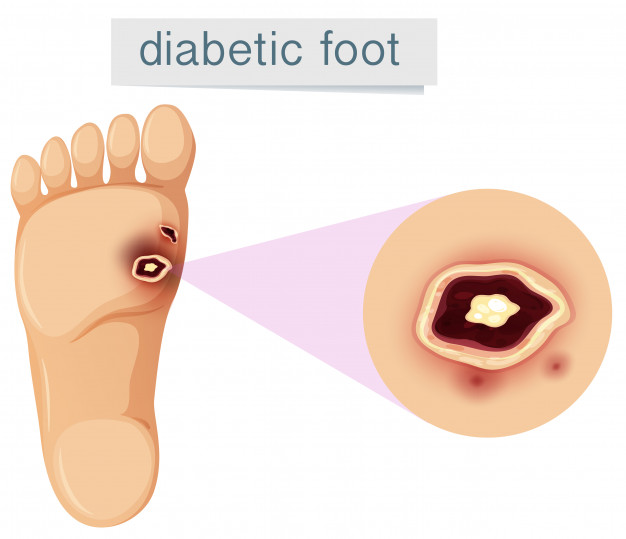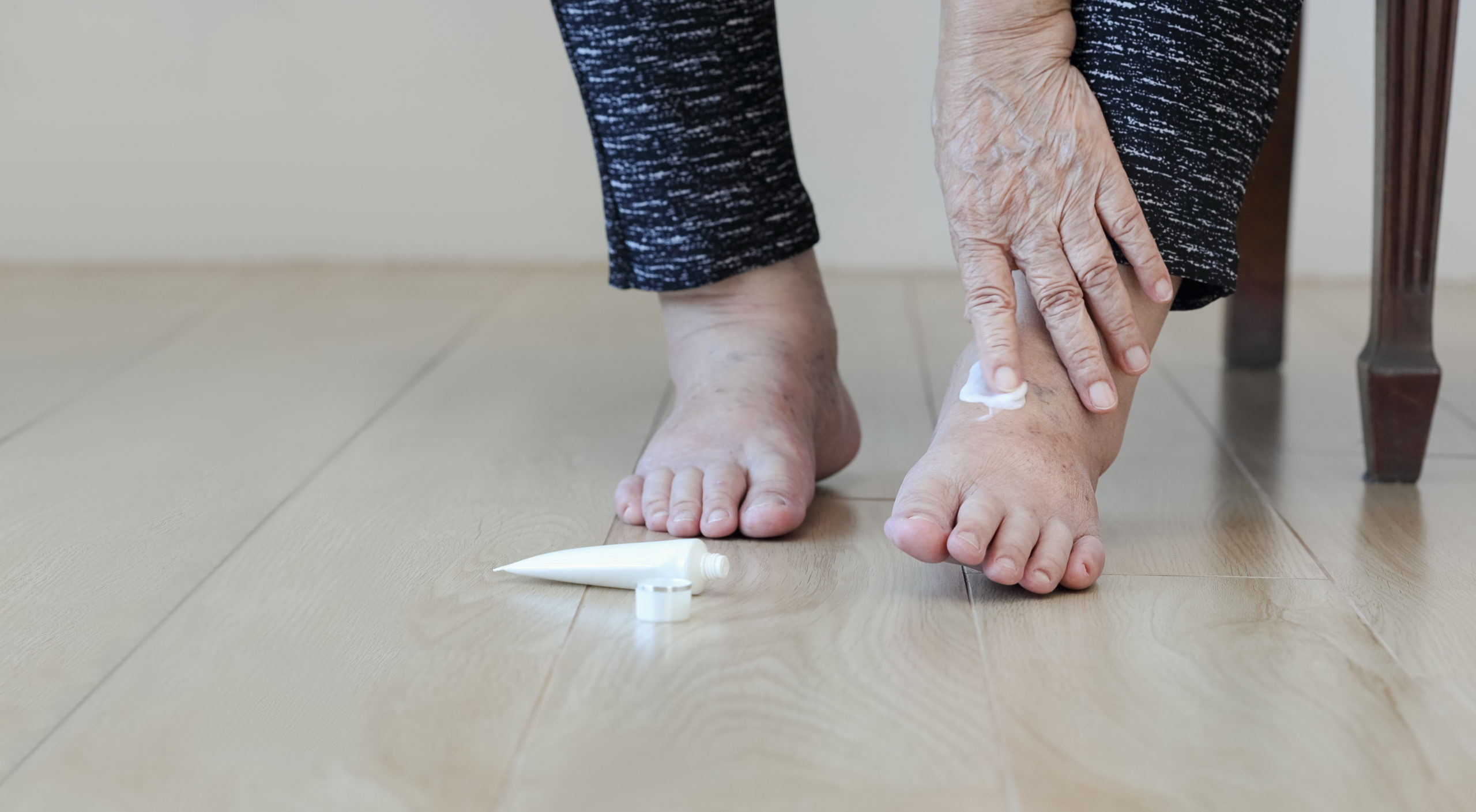Book Your Appointment
Diabetic Foot
Healthcare Services
Get At Swasthyam Superspeciality Hospital
Diabetic Foot Care
If you have diabetes, having too much glucose (aka sugar) in your blood for a long time can cause some serious complications, including foot problems.

How Can Diabetes Affect My Feet and Some Common Foot Problems With Diabetes?
Diabetic neuropathy
Uncontrolled diabetes can damage your nerves. If you have damaged nerves in your legs and feet, you might not feel heat, cold, or pain there. This lack of feeling is called “sensory diabetic neuropathy.” If you do not feel a cut or sore on your foot because of neuropathy, the cut could get worse and become infected. The muscles of your foot may not work properly because nerves to the muscles are damaged. This could cause your foot to not align properly and create too much pressure on one part of your foot.
Athlete's foot
Athlete’s foot is a fungus that causes itching, redness, and cracking. Germs can enter through the cracks in your skin and cause an infection. Medicines that kill the fungus can treat athlete’s foot. These medicines come in pills or creams.
Calluses
A callus is a buildup of hard skin, usually on the underside of the foot. Calluses are caused by an uneven distribution of weight. Calluses also can be caused by poorly fitting shoes or by a skin problem. It’s normal to have some callus on your foot, so your doctor will decide if your callus is causing problems. If you have a callus, take care of it properly. After your bath or shower, use a pumice stone to gently remove the
Blisters
Blisters can form when your shoes rub the same spot on your foot. Wearing shoes that do not fit properly or wearing shoes without socks can cause blisters, which can become infected. When treating blisters, it’s important not to “pop” them. The skin covering the blister helps protect it from infection. Use an antibacterial cream and clean, soft bandages to protect the skin and prevent infection.
Dry skin
Dry skin can crack, which can allow germs to enter. Use moisturizing soaps and lotions to keep your skin moist and soft. Ask your doctor which ones to use.
- Diabetic ulcers. A foot ulcer is a break in the skin or a deep sore. They can become infected. Foot ulcers can happen from minor scrapes, cuts that heal slowly, or from the rubbing of shoes that do not fit well. It’s important to treat them as soon as you notice them. Ask your doctor for advice on how to best care for your ulcer. Up to 10% of people with diabetes will get foot ulcers.
Peripheral vascular disease
Diabetes also affects the flow of blood. Without good blood flow, it takes longer for a sore or cut to heal. Poor blood flow in the arms and legs is called “peripheral vascular disease.” If you have an infection that will not heal because of poor blood flow, you are at risk for developing ulcers or gangrene (the death of tissue due to a lack of blood).
Fungal infection of nails
Nails that are infected with a fungus may become discolored (yellowish-brown or opaque), thick, and brittle and may separate from the rest of your nail. In some cases, your nail may crumble. The dark, moist, and warm environment of shoes can help a fungus grow. An injury to your nail can also lead to a fungal infection. Fungal nail infections are hard to treat. Medications applied to the nail are available, but they only help a small number of fungal nail problems. You may need prescription medicine that you take by mouth. Your doctor might also remove the damaged nail.
Corns
A corn is a buildup of hard skin near a bony area of a toe or between toes. Corns may happen because of pressure from shoes that rub against your toes or cause friction between your toes. Be sure to take care of them properly. After your bath or shower, use a pumice stone to gently remove the built-up tissue. Do not use over-the-counter remedies to dissolve corns. DO NOT try to cut the corn or remove it with a sharp object.
Bunions
A bunion forms when your big toe bends toward your second toe. Often, the spot where your big toe joins your foot becomes red and callused. This area also may stick out and become hard. Bunions can form on one or both feet. They may run in the family, but most often they’re caused by wearing high-heeled shoes with narrow toes. These shoes put pressure on your big toe, pushing it toward your second toe. Felt or foam padding may help protect the bunion from irritation. Your doctor can also use a device to separate the big and second toes. If the bunion causes severe pain or deformity, you might need surgery to realign your toes.
Hammertoes
A hammertoe is a toe that is bent because of a weakened muscle. The weakened muscle makes the tendons in your toe shorter, causing your toe to curl under your foot. Hammertoes can run in families. They can also be caused by shoes that are too short. Hammertoes can cause problems with walking and can lead to blisters, calluses, and sores. Splints and corrective shoes can treat them. In severe cases, you may need surgery to straighten your toes.
Tips for Diabetic Foot Care
Proper foot care can prevent these common foot problems or treat them before they cause serious complications. Here are some tips for good foot care:
- Take care of yourself and your diabetes. Follow your doctor’s advice regarding nutrition, exercise, and medication. Keep your blood sugar level within the range recommended by your doctor.
- Wash your feet in warm water every day, using a mild soap. Test the temperature of the water with your elbow because nerve damage can affect sensation in your hands, too. Do not soak your feet. Dry your feet well, especially between your toes.
- Check your feet every day for sores, blisters, redness, calluses, or any other problems. If you have poor blood flow, it is especially important to check your feet daily.
- If the skin on your feet is dry, keep it moist by applying lotion after you wash and dry your feet. Do not put lotion between your toes. Your doctor can tell you which type of lotion is best.
- Gently smooth corns and calluses with an emery board or pumice stone. Do this after your bath or shower, when your skin is soft. Move the emery board in only one direction.
- Check your toenails once a week. Trim your toenails with a nail clipper straight across. Do not round off the corners of toenails or cut down on the sides of the nails. After clipping, smooth the toenails with a nail file.
Signs of Diabetic Foot Problems
If you have diabetes, contact your doctor if you have any of these problems:
- Changes in skin color
- Changes in skin temperature
- Swelling in the foot or ankle
- Pain in the legs
- Open sores on the feet that are slow to heal or are draining
- Ingrown toenails or toenails infected with fungus
- Corns or calluses
- Dry cracks in the skin, especially around the heel
- Foot odor that is unusual or won’t go away


Who is a Podiatrist?
A podiatrist is a Doctor of Podiatric Medicine (DPM). A podiatrist has specialized training to treat disorders of the foot and ankle. Currently, they must complete the following formal education:
- Four years of undergraduate school
- Four years at an accredited podiatric medical school
- Three to four years of only foot and ankle surgical residency training
They receive medical training plus specialized training on the foot, ankle, and lower leg. They are also extremely well trained in biomechanics and proper foot balance and therefore well equipped to fit orthotics, custom shoes, and a variety of braces. Podiatrists study medicine as it relates to feet, during the entire course of study. They spend their entire surgical residency training on the foot and ankle, often with multiple podiatric and orthopedic surgeons. Therefore, they have more years of study that is focused specifically on feet.
Message Us
Get In touch with us. Ask Any Question or Book Your Appointment Now
Emergency
+91-8600888444
Book An Appointment
0712-2222111
Contact Us
Location
97/98 Vivekanand Nagar, Near Sai Mandir, Wardha Road, Nagpur
Contact for
Emergency :- +91-8600888444
Book An Appointment:- 0712-2222111
